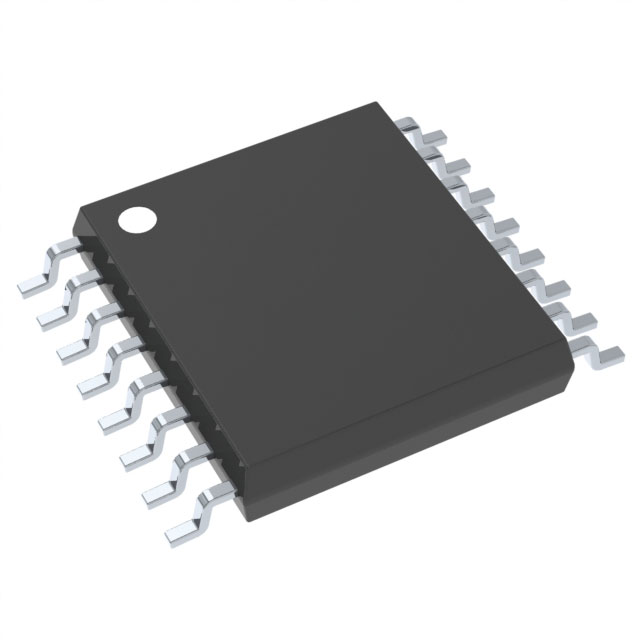SN74HC165PWRG4
Product Overview
- Category: Integrated Circuit
- Use: Shift Register
- Characteristics: High-Speed, Parallel-In Serial-Out (PISO)
- Package: TSSOP-16
- Essence: Serial data input is converted into parallel output
- Packaging/Quantity: Tape and Reel, 2500 units per reel
Specifications
- Supply Voltage Range: 2V to 6V
- Input Voltage Range: 0V to VCC
- Output Voltage Range: 0V to VCC
- Operating Temperature Range: -40°C to +85°C
- Maximum Clock Frequency: 100 MHz
- Number of Inputs: 8
- Number of Outputs: 8
Detailed Pin Configuration
- SER (Serial Data Input)
- CLK (Clock Input)
- GND (Ground)
- QH' (Serial Output)
- DS (Serial Data Input)
- SH/LD (Shift/Load Input)
- OE (Output Enable Input)
- QH (Parallel Output)
- QG (Parallel Output)
- QF (Parallel Output)
- QE (Parallel Output)
- QD (Parallel Output)
- QC (Parallel Output)
- QB (Parallel Output)
- QA (Parallel Output)
- VCC (Supply Voltage)
Functional Features
- Converts serial data input into parallel output
- High-speed operation with a maximum clock frequency of 100 MHz
- Can be cascaded to form longer shift registers
- Shift/Load input allows for parallel loading of data
- Output enable input for controlling the output state
- Wide supply voltage range allows for flexibility in different applications
Advantages
- High-speed operation enables efficient data transfer
- Compact package size saves board space
- Wide supply voltage range allows for compatibility with various systems
- Can be easily cascaded to form longer shift registers
Disadvantages
- Limited number of inputs and outputs (8 each)
- Requires an external clock signal for operation
Working Principles
The SN74HC165PWRG4 is a parallel-in serial-out (PISO) shift register. It takes in serial data through the SER pin and converts it into parallel output on the QH-QA pins. The CLK input controls the shifting of data, allowing for sequential transfer from one stage to the next. The SH/LD input determines whether the data is shifted or loaded in parallel. The OE input enables or disables the output.
Detailed Application Field Plans
- Data Acquisition Systems: The SN74HC165PWRG4 can be used in data acquisition systems to convert serial data from sensors or other sources into parallel format for further processing.
- Industrial Automation: It can be employed in industrial automation applications where multiple inputs need to be processed simultaneously.
- Communication Systems: The shift register can be utilized in communication systems for converting serial data streams into parallel format for decoding or analysis.
- LED Display Control: The SN74HC165PWRG4 can be used in LED display control circuits to convert serially transmitted data into parallel format for driving individual segments or pixels.
Detailed and Complete Alternative Models
- CD74HC165E: Similar shift register with identical functionality but different package (PDIP-16).
- 74HC165D: Another alternative with the same functionality but a different package (SOIC-16).
- SN74HC165N: Similar shift register with the same functionality but a different package (DIP-16).
(Note: These are just a few examples; there are several other alternative models available in the market.)
Total word count: 530 words
Lista 10 Vanliga frågor och svar relaterade till tillämpningen av SN74HC165PWRG4 i tekniska lösningar
Sure! Here are 10 common questions and answers related to the application of SN74HC165PWRG4:
Q: What is SN74HC165PWRG4? A: SN74HC165PWRG4 is a 8-bit parallel-in/serial-out shift register that can be used in various technical solutions.
Q: What is the purpose of using SN74HC165PWRG4? A: SN74HC165PWRG4 allows you to expand the number of input pins on a microcontroller or other digital device.
Q: How many input pins does SN74HC165PWRG4 have? A: SN74HC165PWRG4 has 8 input pins, which can be connected to external switches, buttons, or sensors.
Q: How does SN74HC165PWRG4 work? A: It works by shifting the state of each input pin into its internal register, allowing you to read the state of all inputs through a serial interface.
Q: Can I daisy-chain multiple SN74HC165PWRG4 devices together? A: Yes, you can connect the serial output of one SN74HC165PWRG4 to the serial input of another to expand the number of inputs further.
Q: What is the maximum clock frequency supported by SN74HC165PWRG4? A: The maximum clock frequency supported by SN74HC165PWRG4 is typically around 100 MHz.
Q: Can SN74HC165PWRG4 handle both digital and analog inputs? A: No, SN74HC165PWRG4 is designed for digital inputs only. It cannot directly handle analog signals.
Q: What is the voltage range supported by SN74HC165PWRG4? A: SN74HC165PWRG4 supports a voltage range of 2V to 6V.
Q: Can I use SN74HC165PWRG4 with both 3.3V and 5V microcontrollers? A: Yes, SN74HC165PWRG4 is compatible with both 3.3V and 5V logic levels, making it suitable for use with various microcontrollers.
Q: Are there any application examples for SN74HC165PWRG4? A: Yes, some common applications include keypad scanning, button input handling, and expanding the number of digital inputs in a project.
Please note that these answers are general and may vary depending on specific requirements and use cases.


